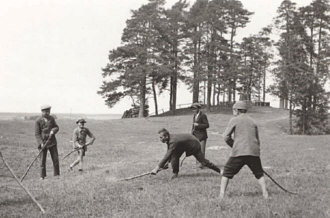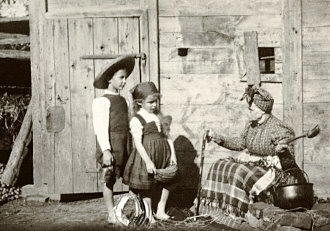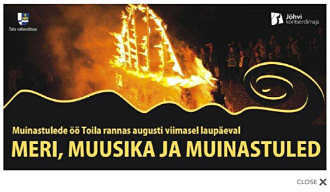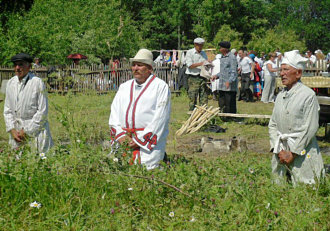Mäetagused vol. 89
Summary
-
Changing images of children and children’s innovative energy
-
 Trihvaa, Uka-uka, and Other Estonian Hiding Games in the 20th Century
Trihvaa, Uka-uka, and Other Estonian Hiding Games in the 20th Century
Astrid Tuisk
Education Coordinator, Research Fellow
Estonian Folklore Archives, Estonian Literary Museum
astrid.tuisk@folklore.ee
Keywords: children’s game, gameplay, spread of folklore
Even though Estonia underwent significant societal changes in the 20th century, Estonian children played exciting running and hiding games both at the beginning and end of the century. The game repertoire evolved throughout these hundred years, with some running and hiding games being introduced, and others forgotten. My article focuses on the points of contact between Estonian games and those of neighbouring peoples, their distribution in Estonia, and the changes the games underwent, along with the reasons behind these changes.
The article explores various Estonian running and hiding games, such as peitus or hide-and-seek, ukraadina (cf. Russian ukradina ‘lost’ or ‘stolen’) also known as uka-uka (Block, Forty-Forty, cf. also Russian tuki-tuki), the wall tag game trihvaa/trihvaater (cf. German Trivater, Verstecken mit Anschlagen), the hiding game kopupeit, involving knocking, the game of casting a stick called paalka viskamine, and the game of 12 (10) sticks.
As to my sources, I have extensively used descriptions of games archived and held in the Estonian Folklore Archives at the Estonian Literary Museum. Nationwide competitions for collecting games were conducted in the years 1934–1935 and again in 1992 but recording and transcribing of the games continued throughout the intervening years.
The games discussed here fall between the categories of running and hiding games. For the sake of clarity and based on one of the primary activities of these games, I will refer to them as hiding games. In all these games, there is one caller (or occasionally two) and several players (“hiders”), and the tagging is done in a specific manner at a designated spot. The players use either one stick or several, touching the spot with one’s hand or knocking, while reciting specific words. Only the game of hide-and-seek does not necessarily involve tagging or running to a specific spot before time runs out, as the caller simply has to find all the hiding players. Typically, the first player found becomes the caller in the next round of the game.
Hiding games are known internationally. Located in Eastern Europe, Estonia has been influenced by the Eastern Slavic, Germanic, and Scandinavian cultural spheres, and close contacts with other nations are reflected also in the spread of the game repertoire. The name for the game trihvaa was most likely adopted by Estonian children by mediation of Baltic Germans from the (Low) German language, while other names (ukraadina, uka-uka, and tuki-tuki) suggest the Russian origin of the games.
Children’s folklore preserves the old, but it is also receptive to the new. Thus, in the 20th century, the tradition of hiding games reveals the preservation of the older tradition but also the changing of the games and the rapid adoption of newer developments. The games have reached us by different routes and at different times, and this is reflected in their names and distribution.
The changes took place fairly rapidly; for example, the little-known ukraadina evolved into the highly popular uka-uka in the northern part of Estonia in just 25 years. At the same time, a similar game, trihvaa, has retained its original name and localisation in South Estonia. Another game with similar rules is called tuki-tuki, a name that emerged in the second half of the 20th century. The game has the same name in the Russian language and among Russian-speaking Estonian children. Its sporadic spread in Estonia (e.g., in Pärnu and Viru counties) suggests that the game was introduced in Estonia by the Russian-speaking population. By the end of the 20th century, all the mentioned games had begun to resemble each other.
Several tag games involving knocking with a stick, such as kopupeit and paalka viskamine, the latter being of religious origin from the Seto region, were no longer part of children’s game repertoire by the end of the century. Also, tagging or knocking with a stick disappeared from the games of ukraadina and trihvaa, possibly due to a trend towards simplification in the games or influenced by the same shift in the respective Russian tradition. After the Second World War, most likely in the 1950s–1960s, the game of 12 (10) sticks appeared in the game tradition. A similar game is also known in Finland, Russia, and elsewhere in Eastern Europe.
The appeal of novelty and the close interaction between children of different ethnic backgrounds are factors contributing to the renewal of these games, yet so is also the diminishing interaction between local generations of children, playing in joint playgroups. As a result, a game (e.g., trihvaa) could take on a new name (e.g., tuki-tuki in Pärnu), while the gameplay remained the same. At the same time, the adaptation of the names of the games (e.g., the origin of the name uka-uka, and its colloquial designations triff, trihvakas, ukakas) indicates that games are not merely adopted but also modified to suit one’s language and mindset.
Despite the disruptions of the Second World War (1939–1945) and the ensuing Soviet occupation (1944–1991) on the settlement structure and population composition in Estonia, different periods of the 20th century were rather favourable for the adaptation of games. Games played previously mainly in agrarian settings were adapted to different circumstances in the increasingly urbanised environment and to changes in children’s lifestyle. The tradition of children’s outdoor games continued in a lively and active lore group. The changes in the game tradition related to technological advancements and the advent of online gaming, however, fall outside the scope of this study.
Levkoi, Waschnik, Mr Krokus and others: Baltic German children’s playing and growing environments
Reet Bender
Professor of German Studies
University of Tartu
reet.bender@ut.ee
Keywords: Baltic German cultural history, children’s games, childhood, life history writing, domestic and educational culture
This article focuses on imaginative childhood games and fictional playmates in Baltic German children’s games, as seen in the context of, and in relation to, Baltic German domestic and educational culture. Through reminiscing about these games, a view of the Baltic German domestic environment in all its diversity is opened up. It gives an insight into the mental environment – relationships within the immediate and extended family and domestic circle (which also included servants) and the relationships and interactions beyond, but also shares information about the physical environment – the everyday culture and way of life. And in the midst of it all, of course, the narrators are looking back on their own formative experiences and years. The examples of more or less imaginative games are drawn from the memoirs of nine Baltic German authors, of which one text is available in Estonian translation, while the others are unknown to the Estonian reader as complete texts, and therefore perhaps all the more interesting. The authors have been selected from the corpus of Baltic German memoir texts collected from reading, based on the focus of this article, i.e., texts that also deal with the author’s childhood and where fictional playmates and worlds are also discussed. The selection is certainly not exhaustive, but it provides a preliminary insight into the subject.
Baltic German memoir literature, especially concerning the generations whose childhoods passed during a period of stability and peace – whether at the end of the 19th century before Russification, or the pre-World War I era – often exhibits a particular contrast. Childhood and youth were left behind at a time when the world was still in order, when the life as it used to be had not collapsed. Later Baltic Germans very often wrote memoirs with their descendants in mind, in order to create a generational link, to introduce the lost world and way of life, but also to generalise the impact of historical events from the individual level to the national group as a whole. Post-World War II memory work directed at descendants became particularly significant, as everything had once again and irreversibly gone.
The examples of imaginative childhood games and fictional playmates in the Baltic German memoirs discussed in this article carry a positive tone, occasionally accompanied by a light-hearted and wise reflection. Children were encouraged to engage in independent play, while not being neglected, especially the younger children, for whom the presence of an ‘interested adult’ in the background was noticeable. Storytelling and literature played a key role in the development of imagination and creativity. The plots of literary works were transferred to games and further developed, and dramatization techniques were employed using readily available resources. In addition to classical and romantic literature, the physical environment – buildings, interiors, the surrounding nature – also exerted important influence. Fictional companions existed both in the case of an only child and in the case of children growing up among siblings. In the latter case, there were often shared fantasy characters and worlds – whether they were just air or on paper. Adults also became part of the imaginary worlds and retained their role as interested observers – as long as the imaginary world did not overflow too much – leaving room for individual originality, which has been considered a distinctive feature of Baltic German society.
The authors recall their childhood with fond memories, where home and family formed a stable, secure and vital growing environment, and the necessary resilience and resourcefulness for coping with life’s challenges. As such, these examples also fit into the framework of what Helene Hoerschelmann calls “old-school Baltic German upbringing”. Undoubtedly, the self-aware adaptability acquired during their childhood and youth served them well – the successive pivotal historical events, wars and revolutions became an inevitable part of their lives.
Thus, a study of the history of the Baltic Germans’ childhood and upbringing could be of interest not only as part of an unknown or forgotten and lost world, but also as a multifaceted source of reflection and comparison, especially from today’s perspective.
 Not merely a toy: A case study of doll Lottchen from the museological perspective
Not merely a toy: A case study of doll Lottchen from the museological perspective
Helena Grauberg
Researcher, Tartu Toy Museum
helena.grauberg@mm.ee
Keywords: childhood, museology, toys, history of dolls, Second World War
Doll Lottchen is an example of a museum object that has changed its nature and functions throughout its lifespan, so it can be described as a toy and as a comfort object, but also as a symbolic item of personal childhood and national identity, and a delicate museum object with restrictions in use.
Doll Lottchen belonged to Anne, who was given it as a gift in 1947, during a film shooting in Saint Petersburg (then Leningrad) by the host of a local family, when she was four years old. She found the little smiling doll lovely and called her Lottchen. Anne believed that the doll was produced in Germany and was probably taken as a trophy by some Soviet soldier at the end of the Second World War, but the moulded mark shows that the doll was made in Okhta factory in Russia. Its origin is still unclear as Rheinische Gummi- und Celluloidfabrik in Germany indeed launched a similar doll called Mädi between 1930 and 1957. The Okhta factory used German moulds in the 1930s and 1940s.
Sometimes detecting the history of the previous usage of a museum object needs effort and time; for Lottchen the material was collected within eight months of communication with the donator. As Lottchen was an affective object or sensitive object (Frykman and Frykman) there are various memories about it. Anne describes three dramatic episodes from her childhood, during which the doll was either temporarily lost or broken by a dog. At the age of ten the life story of Anne and the story of her favourite doll intersected. Accidentally Anne learned from a tipsy neighbour that she was actually a “German girl”. During two years, when she kept this shocking information a secret and made a new costume for the doll, her doll Lottchen acquired a new meaning. When Anne became 12, it was revealed that she had been rescued by her Estonian stepmother from Königsberg in 1946. By then the city had been destroyed by the allies and occupied by the Soviet forces; thousands of civilians had died of diseases and starvation. Anne was three and a half, her biological family had lost the father and two other children, and little Roswitha Anne Browarzyck (her actual name) was very fragile, with her feet swollen from hunger. Miraculously escaped to Estonia with her future stepmother, she had to hide her East-Prussian origin and was not allowed to speak German. So she quickly forgot her real identity. When finally donating the doll to the museum, Anne sent her off with the following words of farewell: “May you, dear Lottchen, have many good friends and excitement on every day at the toy museum! Maybe I’ll come to see you sometime! Hugs, your Rose (that’s how I was called at home).”
As toy museums tend to be places of childhood nostalgy and the Tartu Toy Museum is no exception, there are some dilemmas about dealing with this kind of objects. As they are made of hazardous and fragile celluloid, the best way to preserve them is to keep them in controlled conditions in the repository. Today doll Lottchen is kept this way. However, as a modern museum would like to exhibit its items and share its collections with visitors, there are ethical questions of how to organise it.
It is argued whether the happy-faced doll could be displayed in a showcase together with other celluloid dolls without any explanations, to follow the toy museum’s current policy to keep any war themes or sensitive topics of children’s life as silent as possible. Or should toy museums take a more active part in highlighting uneasy topics and white spots in history? Today the world is dangerous and the ongoing war in Ukraine raises questions about war, forcing parents to find ways to answer them. By means of historical stories about toys and children to whom they belonged, museums could contribute to this task. It seems that the best way could be to conduct visitor´s research among children and adults both through surveys and observations. In this way it could be possible to find out what is preferred and whether and how to deal with difficult topics through temporary exhibitions, events or museum education.

The night of ancient bonfires
Mare Kõiva
Leading Research Fellow
Department of Folkloristics Estonian Literary Museum, Estonia
mare@folklore.ee
Andres Kuperjanov
Research Fellow
Department of Folkloristics Estonian Literary Museum, Estonia
cps@folklore.ee
Keywords: end of August celebration, folklore, imagined past, ritual year, bonfire festival
The article focuses on the initiation, spread, and implementation of the tradition of the night of ancient bonfires, mapping the cultural environment and describing the internal and external socio-cultural factors, as well as connections to identity creation of celebrating the last Sunday in August on the seashore. Data were collected through interviews and observations, and qualitative approach was used to reconstruct the dynamic of private and institutionalised marking. In the 21st century, bonfires are interpreted as remembrance of the past and continuation of tradition, based on ethnic identity. The authors present some comparative phenomena in the vicinity of Europe.
Peculiarities of passing on and reciting incantations in East Slavs
Tatiana Agapkina
Doctor of Letters, Principal Research Fellow
Institute for Slavic Studies, Russian Academy of Sciences
agapi-t@yandex.ru
Keywords: East Slavs, incantations, passing on incantations, magic
The article discusses the peculiarities of passing on incantations by East Slavic sages (znahar’), emphasising the tradition of passing on incantations from one generation to another, inside and outside the family, tendencies of free magic knowledge transfer, as well as limitations to the passing of closing fragments of especially significant incantations (zamok ‘lock’ or zakrepka ‘fastening’). The second part of the article focuses on the rules the healer follows when using incantations as a magical means: attitude to incantations as material objects, practices for restoring the power of incantations, types of sages, as well as rules concerned with choosing the object of incantations.
 Innovations in the priesthood of Eastern Udmurts
Innovations in the priesthood of Eastern Udmurts
Ranus Sadikov
Leading Researcher, Department of Ethnography
R. G. Kuzeev Institute for Ethnological Research, Ufa Federal Research Centre
Russian Academy of Sciences, Russia
kissapi@mail.ru
Keywords: contemporary situation, Eastern Udmurts, priests, traditional religion
This paper, based on the author’s field materials, focuses on the current state of the priesthood of the Trans-Kama (Eastern) Udmurts. It is shown that since the 1990s, with the revival of religious traditions, significant changes have taken place in the organization of the priests’ activities, dictated by the modern realities of life. The main criterion for their choice was the presence of positive moral qualities, in some cases their belonging to the “priestly family”.
Mordvin material in Estonian collections and Mordvin diasporas in Estonia in the late 20th – early 21st centuries
Natalia Ermakov
PhD, Research Fellow
Department of Folkloristics, Estonian Literary Museum
natalia.ermakov@folklore.ee
Keywords: diaspora in Estonia, Estonian-Mordvin Society, Erzyas, preservation of identity, cultural societies, Mokshas, Mordovia
This article focusing on Mordvin material in Estonian collections and Mordvin (Erzya-Moksha) diasporas in Estonia in the late 20th–early 21st centuries is based mainly on materials collected in the period between 1994 and 2016 from the journal KUDO published by the Estonian Mordvin Society and reflecting the diverse life of the diaspora. We have also analysed recorded biographical data of Erzya and Moksha people residing in the Republic of Estonia and the archival material of the Estonian Mordvin Society. The article reviews the history of the first settlers, their number, formation of cultural societies and their interaction with other organisations, integration into Estonian society, information about the first Estonian expeditions to the settlements of the Erzya and Moksha as well as cultural and educational ties between Estonia and Mordovia. All this reveals the activities of compatriots, trends in population change in this group, mechanisms of the preservation of national identity and the role of Mordvin national and cultural non-profit organisations in the preservation and development of ethnic culture in the Republic of Estonia.
In memoriam
Albena Georgieva
16.04.1954 – 2.02.2024
Obituary from Irina Sedakova.
Tatiana Vladykina
8.09.1953 – 4.05.2024
Obituary from Mare Kõiva.
Arvo Valton
14.12.1935 – 26.07.2024
Obituary from Nikolay Kuznetsov.
News in brief
Accessions of the Estonian Folklore Archives in 2023
Risto Järv, Mathilda Matjus and Kadri Tamm write about the Estonian Folklore Archives’ collection year 2023 and President’s Folklore Collection Award, which was granted to Maila Jürgenson, Sirje Võsa, Anu Soon and Liisa Nurme.
Calendar
A brief summary of the events of Estonian folklorists from April to July 2024.
Book review
Latvian incantations in a book and in the digital archive
Aigars Lielbārdis. 150. Kolekcija. Buramvārdi. Sērija: LFK krājums. IV / Collection 150. Charms. ALF Collection IV. Rīga: LU Literatūras, folkloras un mākslas institūts, 2020. 216 pp.
The book is introduced by Daiva Vaitkevičienė.
Dagmar Kutsar
Associate Professor in Social Policy
University of Tartu
dagmar.kutsar@ut.ee
Keywords: images of a child, socially competent child, innovative energy of a child, child’s play
Understanding the child and childhood depends on the content attached to these concepts. Different images have prevailed in different times and they reflect in modern understandings of children.
Drawing on Philippe Ariès’ seminal work, Centuries of Childhood, the paper offers a glimpse of images of children through time. History has portrayed the vulnerable, fragile child who needs protection and the immature child who needs to be educated and disciplined. Both images are represented in adults’ and children’s perceptions of today’s children. These perceptions in turn influence the way adults treat children. For example, a parent who sees the child as vulnerable and fragile may be overprotective and limit the child’s autonomous behaviour; another parent may not be able to negotiate with the child and may be easily punitive in situations where the child makes mistakes. According to children, they do not misbehave deliberately, but because they are immature and lack knowledge and experience. Understandably, they also agree with the image of a vulnerable child – in some situations they need to feel safe and protected.
With the adoption of the Convention on the Rights of the Child by the UN General Assembly in 1989 and its ratification by state governments, the image of the socially competent child began to develop vigorously. The current article focuses on the competent image of the child, according to which a child is an active social agent and socially competent according to age to evaluate his or her lived life. The paper recalls keynotes of Ivar Frønes and Asher Ben-Arieh at international children’s well-being conference which was held in Tartu in 2019. According to them, while an adult thinks about life lived today, and thinking about tomorrow is the quest to “think out of the box”, a child has to live life forward each day, i.e., find solutions here and now, harnessing their innovative energy; for example, when confronted with new situations that require new solutions, or when interpreting and reproducing knowledge individually and collectively, shaping the world in which they live and, last but not least, bringing about change around them, e.g., contributing to the parent’s growth into parenthood. The challenge of modern childhood is to understand social processes in a forward-looking way, focusing not on future adulthood but on the here-and-now of childhood. Children use their innovative energy in everyday interactions and play, which is an important part of their lives. In a broad sense, play is action, it is practice of living, including the development of new skills and self-socialisation. There is plenty of innovative energy in children in their free play. In conclusion, it has to be said that, as society develops more rapidly, innovative energy and thinking are increasingly becoming a challenge for adults too.
The article is based on the introductory presentation of the winter conference of folklorists, “Playing and Playfulness in Folklore”, held in Kuremaa Castle on 2–3 March 2023.